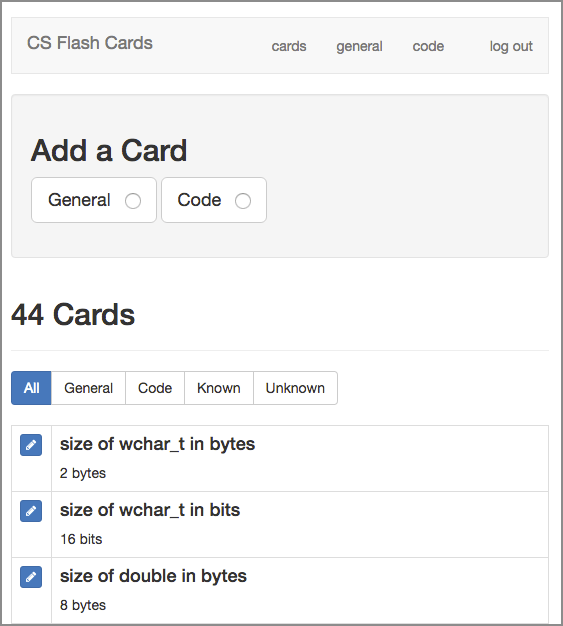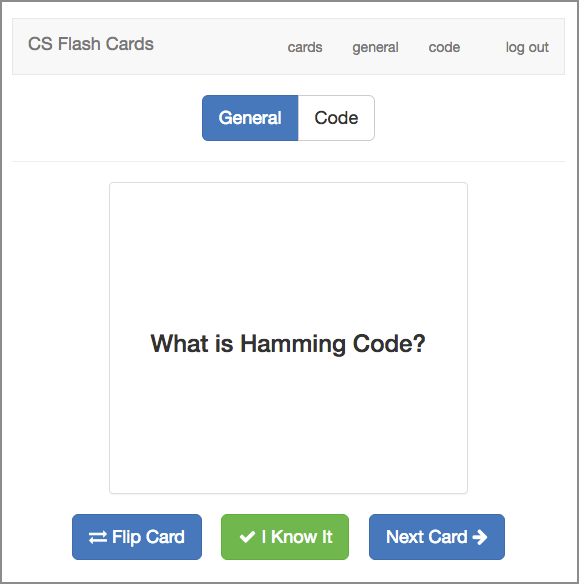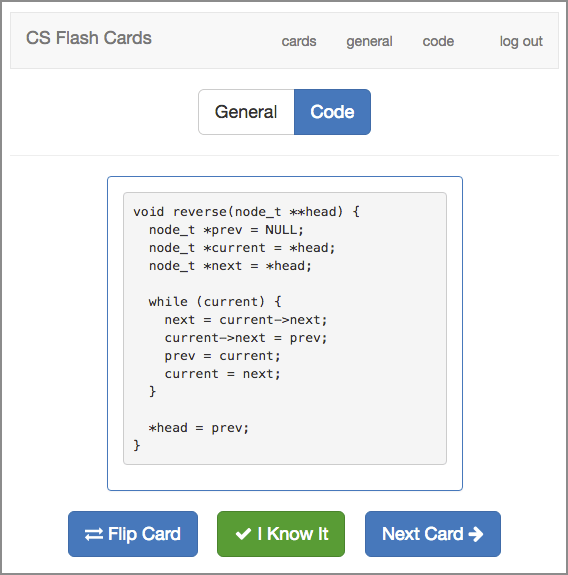Computer Science Flash Cards
This is a little website I've put together to allow me to easily make flash cards and quiz myself for memorization of:
- general cs knowledge
- vocabulary
- definitions of processes
- powers of 2
- design patterns
- code
- data structures
- algorithms
- solving problems
- bitwise operations
Will be able to use it on: - desktop - mobile (phone and tablet)
It uses:
- Python 3
- Flask
- SQLite
About the Site
Here's a brief rundown: https://googleyasheck.com/flash-cards-site-complete/
Screenshots
UI for listing cards. From here you can add and edit cards.
The front of a General flash card.
The reverse (answer side) of a Code flash card.
Important Note
The set included in this project (cards-jwasham.db) is not my full set, and is way too big already.
Thanks for asking for my list of 1,792 cards. But it’s too much. I even printed them out. It’s 50 pages, front and back, in tiny text. It would take about 8 hours to just read them all.
My set includes a lot of obscure info from books I’ve read, Python trivia, machine learning knowledge, assembly language, etc.
I've added it to the project if you want it (cards-jwasham-extreme.db). You've been warned.
Please make your own set, and while you’re making them, only make cards for what you need to know. Otherwise, it gets out of hand.
How to convert to Anki or CSV
If you don't want to run a server, you can simply use Anki or a similar service/app. Use this script to convert from my sets (SQLite .db file), or yours, to CSV:
https://github.com/eyedol/tools/blob/master/anki_data_builder.py
Thanks @eyedol
How to run it on a server
- Clone project to a directory on your web server.
- Edit the config.txt file. Change the secret key, username and password. The username and password will be the login for your site. There is only one user - you.
- Follow this long tutorial to get Flask running. It was way more work than it should be:
https://www.digitalocean.com/community/tutorials/how-to-serve-flask-applications-with-uwsgi-and-nginx-on-ubuntu-16-04
wsgi.pyis the entry point. It callsflash_cards.py- This is my systemd file
/etc/systemd/system/flash_cards.service: view- you can see the paths where I installed it, and the name of my virtualenv directory
- when done with tutorial:
sudo systemctl restart flash_cards sudo systemctl daemon-reload - When you see a login page, you're good to go.
- Log in.
- Click the "General" or "Code" button and make a card!
- When you're ready to start memorizing, click either "General" or "Code" in the top menu.
How to run it on local host (Quick Guide)
Provided by @devyash - devyashsanghai@gmail.com - Reach out to this contributor if you have trouble.
-
Install dependencies:
-
Install Python
-
Add python as environment variable windows
-
To install pip, securely download get-pip.py
-
Run
python get-pip.pyin terminal -
Run
pip install -r requirements.txtin terminal after going to correct folder -
Open flash_cards.py and uncomment the line 52-55 begining from
@app.route('/initdb') -
Type
python flash_cards.py -
Login using id:USERNAME='admin', PASSWORD='default. Open localhost:5000/initdb
Every time you wish to run your db just open folder in terminal and run python flash_cards.py
How to run with Docker
Provided by @Tinpee - tinpee.dev@gmail.com - Reach out to this contributor if you have trouble.
Make sure you already installed docker
- Clone project to any where you want and go to source folder.
- Edit the config.txt file. Change the secret key, username and password. The username and password will be the login for your site. There is only one user - you.
- Build image:
docker build . -t cs-flash-cards - Run container:
docker run -d -p 8000:8000 --name cs-flash-cards cs-flash-cards - Go your browser and type
http://localhost:8000
If you already had a backup file cards.db. Run following command:
Note: We don't need to rebuild image, just delete old container if you already built.
docker run -d -p 8000:8000 --name cs-flash-cards -v :<path_to_folder_contains_cards_db>:/src/db cs-flash-cards.
<path_to_folder_contains_cards_db>: is the full path contains cards.db.
Example: /home/tinpee/cs-flash-cards/db, and cards.db is inside this folder.
For convenience, if you don't have cards.db, this container will auto copy a new one from cards-empty.db.
How to backup data ?
We just need store cards.db file, and don't need any sql command.
- If you run container with
-v <folder_db>:/src/dbjust go tofolder_dband storecards.dbanywhere you want. - Without
-v flag. Type:docker cp <name_of_container>:/src/db/cards.db /path/to/save
How to restore data ?
- Delete old container (not image):
docker rm cs-flash-cards - Build a new one with
-v flag:docker run -d -p 8000:8000 --name cs-flash-cards -v <path_to_folder_contains_cards_db>:/src/db cs-flash-cards - Voila :)
Alternative for Node fans
@ashwanikumar04 put together an alternative flash cards site running Node: https://github.com/ashwanikumar04/flash-cards
Check out the demo!
Happy learning!


